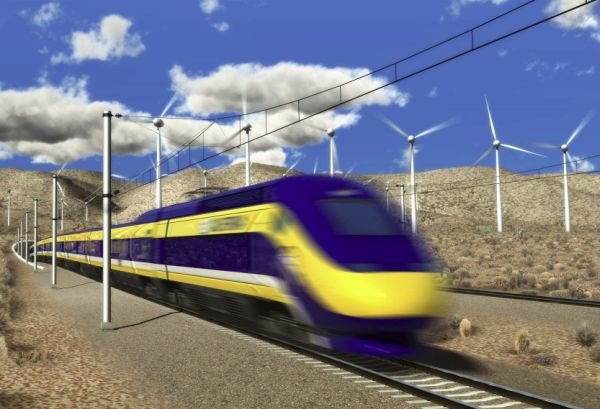Wind-Powered Trains: Reducing Pollution And Saving Energy

Table of Contents
The Technology Behind Wind-Powered Trains
Harnessing Wind Energy
Several methods are being explored to capture wind energy for trains. These include:
- Trackside Wind Turbines: Large-scale wind turbines positioned alongside railway lines could generate significant power, feeding electricity directly into the train's power system via overhead lines or wireless transmission. This approach benefits from economies of scale but requires substantial initial infrastructure investment and land acquisition.
- Onboard Wind Turbines: Smaller, more compact wind turbines could be integrated onto the trains themselves. This offers a degree of self-sufficiency, especially for shorter journeys or in areas with less consistent trackside wind. However, onboard turbines are generally less powerful and may impact train aerodynamics.
- Hybrid Systems: Combining wind energy with existing power sources like overhead lines offers a practical interim solution. This approach leverages the reliability of traditional power while gradually incorporating renewable energy, minimizing reliance on fossil fuels.
Pros and Cons Summary:
| Method | Pros | Cons |
|---|---|---|
| Trackside Turbines | High power output, cost-effective in the long run | High initial investment, land acquisition challenges, visual impact |
| Onboard Turbines | Self-sufficiency, reduced reliance on external power sources | Lower power output, potential aerodynamic drag |
| Hybrid Systems | Reliability, gradual transition to renewables | Requires investment in both renewable and traditional infrastructure |
Energy Storage and Management
The intermittent nature of wind power presents a challenge. Effective energy storage solutions are crucial to ensure a consistent power supply for wind-powered trains. Options include:
- Lithium-ion Batteries: Currently the most prevalent technology, offering high energy density but with limited lifespan and environmental concerns related to their production and disposal.
- Supercapacitors: Provide faster charging and discharging rates than batteries but have lower energy density. They are ideal for short bursts of high power demands.
- Hydrogen Fuel Cells: Offer clean energy conversion, but require efficient and sustainable hydrogen production methods to avoid increasing carbon emissions.
Storage Solution Comparison:
| Solution | Advantages | Disadvantages |
|---|---|---|
| Lithium-ion Batteries | High energy density, mature technology | Limited lifespan, environmental concerns |
| Supercapacitors | Fast charging/discharging, long lifespan | Lower energy density |
| Hydrogen Fuel Cells | Clean energy, high efficiency | Requires sustainable hydrogen production methods |
Integration with Existing Rail Infrastructure
Integrating wind-powered trains into existing railway networks requires careful planning and significant modifications. Challenges include:
- Upgrading Power Substations: Existing substations may need upgrades to handle the fluctuating power input from wind energy sources.
- Modifying Train Carriages: Integrating wind energy systems (turbines, batteries, etc.) into existing train carriages will require substantial modifications.
- Signal System Compatibility: Ensuring compatibility between wind-powered trains and existing signaling systems is crucial for safe and efficient operation.
- Maintenance and Repair: Establishing reliable maintenance procedures for wind turbines and energy storage systems is vital.
Environmental Benefits of Wind-Powered Trains
Reduced Greenhouse Gas Emissions
Replacing diesel or coal-powered trains with wind-powered alternatives offers significant environmental advantages. Studies suggest that wind-powered trains could reduce greenhouse gas emissions by up to 90% compared to diesel trains. This translates to a substantial decrease in CO2, NOx, and particulate matter emissions, leading to improved air quality and mitigating climate change.
- Significant reduction in CO2 emissions.
- Lower levels of particulate matter and other pollutants improving air quality.
- Reduced reliance on fossil fuels, enhancing energy security.
Sustainable Transportation Solutions
Wind-powered trains align perfectly with global climate goals and efforts to transition towards sustainable transportation. Their adoption contributes to a greener, more environmentally friendly railway system, decreasing the overall carbon footprint of the transport sector.
- Cleaner alternative to traditional railway systems, promoting sustainable development.
- Contribution to achieving net-zero emission targets.
- Reduced noise pollution compared to diesel trains in some configurations.
Economic Aspects of Wind-Powered Trains
Initial Investment Costs
The initial investment in wind-powered train technology is undeniably substantial. It includes research and development, infrastructure upgrades (trackside turbines, power substations), and the manufacturing of wind-powered train carriages. This represents a significant upfront cost compared to conventional railway systems.
- High initial capital expenditure required for infrastructure development.
- Manufacturing costs for wind turbines, energy storage systems, and modified train carriages.
Long-Term Cost Savings and Economic Opportunities
Despite the high initial investment, the long-term economic benefits of wind-powered trains are considerable. These include:
- Reduced operational costs due to lower fuel expenses.
- Job creation in the renewable energy and railway sectors, stimulating economic growth.
- Increased energy independence, reducing vulnerability to fluctuating fossil fuel prices.
Challenges and Future Outlook for Wind-Powered Trains
Technological Hurdles
Several technological challenges remain to be addressed before wind-powered trains become widespread:
- Improving energy storage capacity to ensure reliable power supply, even during periods of low wind.
- Ensuring robustness and reliability of wind turbine systems in varied weather conditions.
- Developing efficient and cost-effective hydrogen production methods for fuel cell applications.
Policy and Regulatory Frameworks
Supportive government policies and clear regulatory frameworks are essential for promoting the adoption of wind-powered trains. These could include:
- Government subsidies and incentives to encourage investment in wind-powered train technology.
- Streamlined approval processes for infrastructure development projects.
- Development of clear standards and regulations for safety and interoperability.
Conclusion
Wind-powered trains offer a compelling solution for creating a cleaner, more sustainable railway system. The advantages – reduced pollution, energy savings, and long-term economic benefits – are undeniable. While technological and regulatory challenges remain, continued research and development, coupled with supportive government policies, are crucial to unlocking the full potential of this innovative technology. Learn more about the advancements in wind-powered train technology and join the movement towards cleaner, greener transportation. Let's embrace the future of renewable energy trains and pave the way for a more sustainable railway system.

Featured Posts
-
 Tomatins Strathdearn Affordable Housing Project Commences With Groundbreaking Ceremony
May 04, 2025
Tomatins Strathdearn Affordable Housing Project Commences With Groundbreaking Ceremony
May 04, 2025 -
 The Future Of Electric Motors Diversifying Supply Chains Beyond China
May 04, 2025
The Future Of Electric Motors Diversifying Supply Chains Beyond China
May 04, 2025 -
 Key Injury Blow For Nuggets In Game Against Okc Thunder
May 04, 2025
Key Injury Blow For Nuggets In Game Against Okc Thunder
May 04, 2025 -
 Edwards Reveals Berlangas Money Driven Fight Selection Bypassing Plant Focusing On Damaged Munguia
May 04, 2025
Edwards Reveals Berlangas Money Driven Fight Selection Bypassing Plant Focusing On Damaged Munguia
May 04, 2025 -
 A Simple Favor Premiere Anna Kendricks Comments On Blake Lively Spark Speculation
May 04, 2025
A Simple Favor Premiere Anna Kendricks Comments On Blake Lively Spark Speculation
May 04, 2025
